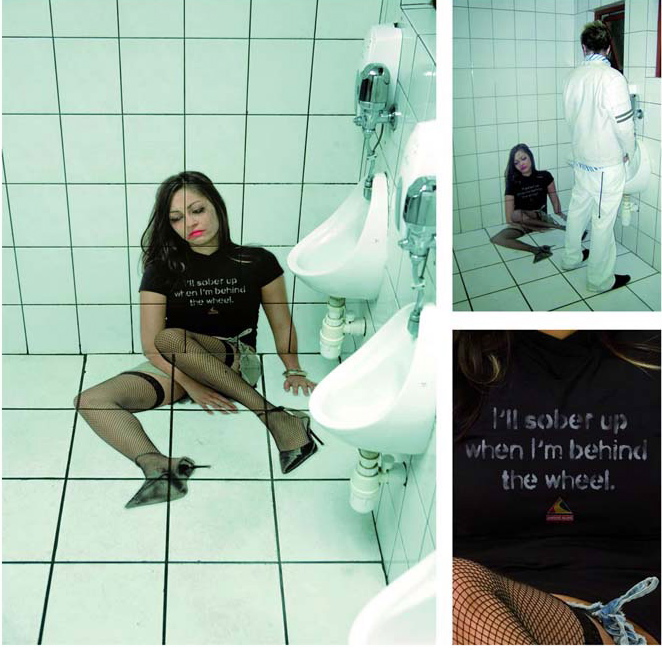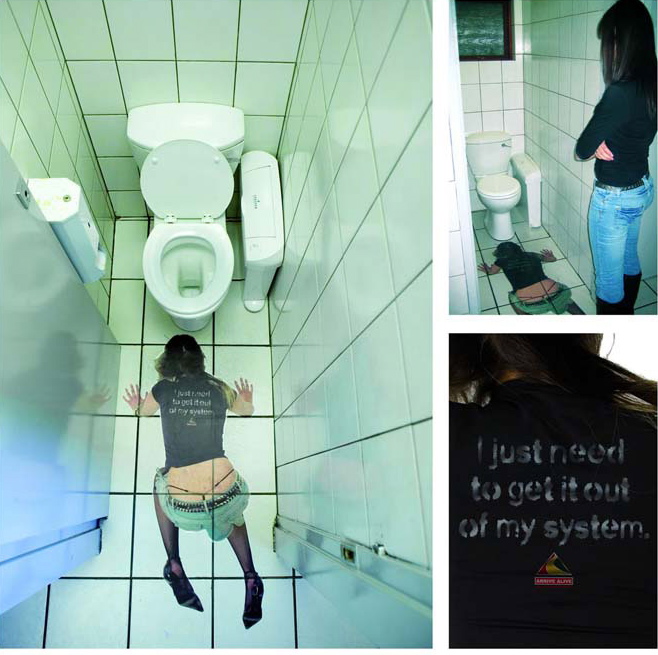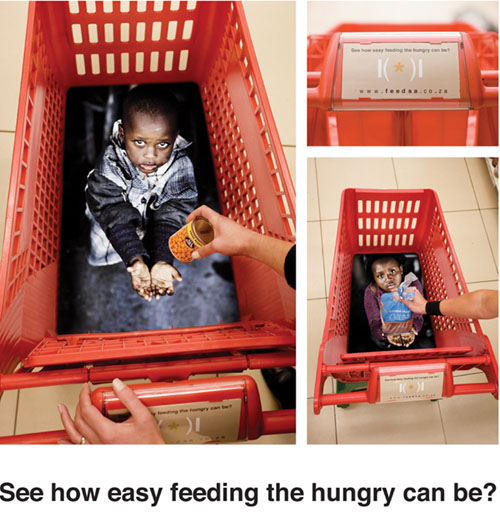Arrive Alive is an anti-drunk driving organization. As part of one educational campaign, they designed these…stickers? posters? stick-ons? I’m not sure what you call them, but things to stick on the wall of public bathrooms to make people think before driving drunk. Here are two examples (found at copyranter):
I don’t quite know what to make of these. I mean, they definitely get your attention. But I also question the outfit they chose to show her in–what’s with sexing her up so much? With fishnet thigh-highs, a visible g-string, and stilettos, no less. And as copyranter points out, for the type of guys (and I know this is a specific group–this isn’t referring to men in general) who look for drunk women to have sex with, I think that top image might have a totally different effect than the organization is getting at. Maybe that’s part of the point–to scare women with the threat of making bad sexual choices (or being forced into sexual activities) while drunk. But then why put it in the men’s bathroom? I’m kind of stumped, really. Readers?
Just a side note, I’m thinking the poster at the top, next to the urinal, is just going to get peed on a lot (after all, there are already lots of urinals shaped like women), while the bottom one is likely to get puked on now and then.
This just strikes me as another example of a PSA that manages to be creepy without necessarily being effective.
Here’s a somewhat similar example. These ads are for Feed SA, a New Zealand-based organization to provide food to people in South Africa. They paid some supermarkets to put these ads in shopping baskets (images posted by copyranter at Animal New York):
I guess part of the point here is to make people feel uncomfortable while they’re filling their baskets with lots of food, in the hopes that they’ll go home and make a donation. And that, in and of itself, doesn’t surprise me; I used to foster dogs for a dog rescue, and let me tell you, we weren’t above occasionally using guilt or desperate appeals if we were in dire shape, and I think it’s a fairly standard (though not necessarily effective) practice among charity organizations. I’m not entirely certain why I find them disconcerting. Maybe there’s no good reason for it.
Readers, what do you think?




Comments 16
Darin — December 14, 2008
I really dislike the shopping cart. Firstly, I'm going to a store to spend money on their products and they try to make extra money off advertising to me. And it seems like a bad economically decision from the stores point because people are going to buy less food.
A better idea I've seen is having a large donation bin that you see when you enter the store. When you're shopping you can buy some non-perishable things and put them in the bin on your way out.
Sanguinity — December 14, 2008
I dislike the shopping cart: you're supposed to empathize with and respect the child, yet you're going to be piling a whole lot of groceries on its face. You can't conduct the act of shopping without symbolically dissing the kid.
The drunk driving PSAs are... bizarre. And disturbing. They look to my eye to be full of blame-the-victim messages about sexual assault ("if you got assaulted, it's because you dressed like this and got too drunk to stand"), and it's hard to tie that back to drunk driving.
Unless maybe she's supposed to be a prostitute? And they're trying to make the implication that drunk driving is the sort of out-of-control, self-destructive thing that prostitutes would do? And that the male viewer is inherently superior to prostitutes, and thus would have more self-control and self-respect than to drive drunk?
Lazercat — December 14, 2008
Those drunk driving ones are....I don't really know. Looks like someone saw this as an opportunity to make some cheap porno?
I think it's trying to lump drunk driving with acting like a "slut", and saying that if you drive drunk, you deserve to be punished because you're no better than a slut.
Stay classy, Arrive Alive.
anneliese — December 14, 2008
I'm trying to imagine stickers of dishevelled, sexualised young men plastered over public bathroom floors, but I can't even think of what a "sexualised" man looks like.
chuk — December 14, 2008
I think the poster, and the commentators here are sort of out of touch with youth culture.
The woman in the drunk driving add is clearly a caricature of a type you actually do frequently find in clubs. She's the dumb wasted girl, probably underage, that embarrasses herself badly, encouraging everyone to think to themselves, "oh god, I hope I don't look like her when I drink!" For the men, it's generally also a sentiment of, "there's no way I would associate myself with that--any man that would is a scuzzbag" Yes the girl's dress looks silly and objectifying, but have any of you seriously not walked down your city's clubbing strip on a Friday night and not noticed that this is a common style that the women consciously pursue? (I'm not saying that it's good, just that it's accurate)
Personally I despise clubbing culture, but the images allude to norms, symbols, and personalities that are relevant to the club's patrons. The adds are trying to associate drunk driving with the caricature I describe above. I suspect that it is moderately successful at doing so.
Gwen — December 14, 2008
I live in Vegas. I'm quite aware that many women do dress like this. I also know that many young drunk drivers don't look anything like this, and that not all women dress to this degree of sexualization. It was a choice to decide on this particular image to represent drunk drivers, and it seems to be an effort to connect drunk driving to other stigmatized behaviors as well.
And I question whether men would necessarily see her as a woman they wouldn't want to be associated with, as opposed to a willing sexual partner.
I still wonder about its effectiveness. After all, people who are going to drive drunk usually don't consider themselves too drunk to drive, and young people often don't plan ahead, or they have a designated driver who may not stay sober. In general, there's not a lot of evidence that these education-based campaigns have much effect, regardless of the social issue.
Jamal — December 14, 2008
I imagine that most heterosexual males who see this will feel ambivalent - fascinated, aroused, disturbed and confused at the same time. The fact that it is literally intruding into a zone of policed public masculinity, the urinals, causes all sorts of problems for Gwen's 'willing sexual partner' claim. Urinals are not typical sites of male heterosexual fantasy, and even in bars and clubs you can expect that men will prefer to get in and out as quickly as possible without too much dwelling.
I do not see how this promotes any sort of anti-drunk driving 'message' to men, as the drunkenness of the depicted female would primarily be seen to reflect on her poor judgment, as would her choice of apparel. Chuk is right to point out a typology, stereotyping if you like, of the excessively sexual or insufficiently self-controlled 'skank', and to suggest that men might be uncomfortable expressing sexual interest in, much less identifying with such a figure.
Gwen Sharp, PhD — December 14, 2008
To clarify, my point wasn't about most (or even many) men, but simply to say that I'm not sure that it would automatically lead to a sense of revulsion at the idea of seeing or going home with such a girl. But my sense of this might be somewhat distorted due to living in Vegas, where there is maybe more of an open "find a drunk sexual partner and get to the hotel ASAP" among a particular segment of the male tourist population (and, of course, female locals and tourists who either willingly or unintentionally play that role).
To be quite honest, I think most people would see these, think "that's weird," and go on about their business. I doubt it would make many people stop drinking or think too much.
spacedcowgirl — December 14, 2008
The thing that disturbs me the most about the drunk driving ads is that the decal of the woman near the urinals will almost certainly get peed on at some point (as the post stated), but I think it will be by mistake as well as by some guy who thinks its funny to "aim" at it; and that the one in the toilet stall will be stepped on routinely. I'm not even 100% sure what point the ads are trying to make (if you're trying to make drunkenness seem unattractive to men, wouldn't you put up some graphic picture of a young man who just vomited on himself, or one of a man who drove into a ditch and totaled his car because he was drunk? These ads seem, if anything, to send the message that drunk girls are pathetic and "easy" or in danger, which I think is somewhat victim-blaming but I'd think the organization would at least be more inclined to convey that message to women in a women's restroom), but in practice they seem to encourage degradation of women.
The Nerd — December 15, 2008
The one thing I could see becoming a problem with the food ads is that shoppers could quickly become desensitized to the images. After all, they become as common as the shopping cart itself. The idea of a poster in the checkout area is much better, as donating some money can be an "impulse" then.
Cycles — December 15, 2008
"The XXXXX (anything)" has always bothered me. It's dehumanizing. The homeless. The hungry. The poor. They're not people, they're an amorphous blob whose identity is solely defined by a malady-adjective. It's probably extremely low the list of offensive things people say without meaning to offend, but it's always rubbed me the wrong way.
Whenever I see studio shots of people who appear to be in crisis (like the shopping cart kids), I can't help but think: they hired that person to go to a set and make that face for hours as they fiddled with umbrella lights and took hundreds of frames and coached them to make the most pathetic face possible to appeal to the largest number of potential donors. To be fair, it's probably better than using photojournalist-type shots of people in actual turmoil at the site and time of their personal crisis. I guess it's all pretty bad. I guess whatever works to get the most people who are in a position to do something about it off their asses to help fix the problem. In utopia there would be no hunger so NGOs wouldn't be faced with such dilemmas.
Maureen — December 16, 2008
I agree with Cycles about the offensiveness of labeling people as "the poor", etc.
Those images of "poor" children are what I consider poverty porn. They and the many images like them are exploitative, objectifying children and their families in countries around the world to manipulate potential donors. They create a sense that we are some sort of more-evolved savior race that needs to pull their poor little brothers and sisters out of the muck and mire. I really hate that the children have their hands out, begging. What makes this campaign different than the Fagans who send children into traffic to beg for money? Are we supposed to believe that because the money is going to some big Western aid organization (I used to work for one that used these offensive means) that it is somehow morally better to use children for begging? Give me a break.
Frankly, I'm always more disturbed by the exploitation of children more than any other group, so I was more horrified by the images of the shopping carts than the drunk girls, but they were also pretty horrid.
Jamal — December 17, 2008
The power of naming, categorizing, and photographing - to objectify or limit a thing in its being - is not such an unusual thing. We do it to ourselves, to our friends and family, to public villains and to people we do not even know. We're all already objects, but we always seem to break free and act in original ways. Objectifying - exploiting too - is a part of being human, but so many bad sociologists only see a single, negative aspect to it. In effect, they objectify objectification, rendering it foreign and expressing shock and despair whenever someone points it out. When will someone tell these sociologists how bad they are?
Fred — December 11, 2010
I feel that anyone who views this is a loner, someone who has no life and is just willing to give up all sense of love and care...So leave it now.
Anonymous — February 24, 2011
heyy pea
Allen — July 3, 2024
Local trusted plumbers provide reliable emergency plumbing service, available 24/7 to address urgent issues like leaks, burst pipes, and clogged drains. Their skilled professionals ensure prompt and efficient repairs, minimizing damage and restoring normalcy quickly. With a focus on customer satisfaction and quality workmanship, they are the go-to choice for immediate and trustworthy plumbing solutions.